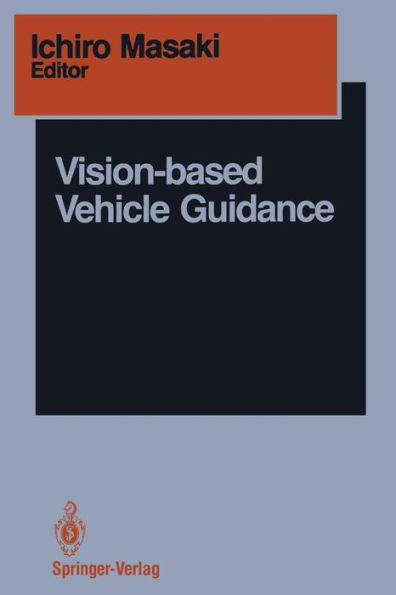5
1


Paperback(Softcover reprint of the original 1st ed. 1992)
$54.99
-
PICK UP IN STORECheck Availability at Nearby Stores
Available within 2 business hours
Related collections and offers
54.99
In Stock
Overview
There is a growing social interest in developing vision-based vehicle guidance systems for improving traffic safety and efficiency and the environment. Ex amples of vision-based vehicle guidance systems include collision warning systems, steering control systems for tracking painted lane marks, and speed control systems for preventing rear-end collisions. Like other guidance systems for aircraft and trains, these systems are ex pected to increase traffic safety significantly. For example, safety improve ments of aircraft landing processes after the introduction of automatic guidance systems have been reported to be 100 times better than prior to installment. Although the safety of human lives is beyond price, the cost for automatic guidance could be compensated by decreased insurance costs. It is becoming more important to increase traffic safety by decreasing the human driver's load in our society, especially with an increasing population of senior people who continue to drive. The second potential social benefit is the improvement of traffic efficiency by decreasing the spacing between vehicles without sacrificing safety. It is reported, for example, that four times the efficiency is expected if the spacing between cars is controlled automatically at 90 cm with a speed of 100 kmjh compared to today's typical manual driving. Although there are a lot of technical, psychological, and social issues to be solved before realizing the high density jhigh-speed traffic systems described here, highly efficient highways are becoming more important because of increasing traffic congestion.

Product Details
| ISBN-13: | 9781461276654 |
|---|---|
| Publisher: | Springer New York |
| Publication date: | 09/26/2011 |
| Series: | Springer Series in Perception Engineering |
| Edition description: | Softcover reprint of the original 1st ed. 1992 |
| Pages: | 332 |
| Product dimensions: | 6.10(w) x 9.25(h) x 0.03(d) |
Table of Contents
1 Vision-based Autonomous Road Vehicles.- 1.1 Abstract.- 1.2 Introduction.- 1.3 Some Experimental Autonomous Road Vehicles.- 1.4 Future Developments.- 1.5 Applications.- 1.6 Conclusions.- References.- 2 The New Generation System for the CMU Navlab.- 2.1 Abstract.- 2.2 Introduction.- 2.3 Color Vision for Road Following.- 2.4 3-D Perception.- 2.5 Planning.- 2.6 Architectures.- 2.7 Maps and Missions.- 2.8 Contributions, Lessons, and Conclusions.- References.- 3 Algorithms for Road Navigation.- 3.1 Introduction.- 3.2 Maryland Road Follower.- 3.3 Recovery of Three-Dimensional Road Geometry.- 3.4 Detection of Stationary Obstacles on Roads.- 3.5 Conclusion.- References.- 4 A Visual Control System Using Image Processing and Fuzzy Theory.- 4.1 Abstract.- 4.2 Introduction.- 4.3 Development of the System.- 4.4 Developed System.- 4.5 Experiment.- 4.6 Conclusion.- 4.7 Further Study.- References.- 5 Local Processing as a Cue for Decreasing 3-D Structure Computation.- 5.1 Abstract.- 5.2 Introduction.- 5.3 Active Vision.- 5.4 Tracking.- 5.5 Conclusion.- References.- 6 Object Detection Using Model-based Prediction and Motion Parallax.- 6.1 Motion Parallax and Object Background Separation.- 6.2 Image Transformation for Motion Relative to a Planar Surface.- 6.3 Estimation of Parameters by Minimization of Prediction Error.- 6.4 Sequential Estimation Using Recorded Sequence.- 6.5 Object Detection Using Prediction Error.- 6.6 Experimental Results and Conclusions.- References.- 7 Road Sign Recognition: A Study of Vision-based Decision Making for Road Environment Recognition.- 7.1 Abstract.- 7.2 Introduction.- 7.3 Technology and Car Equipment.- 7.4 Vision Algorithm.- 7.5 Decision Making.- 7.6 Performances and Conclusions.- References.- 8 From Self-Navigation to Driver’s Associate: AnApplication of Mobile Robot Vision to a Vehicle Information System.- 8.1 Abstract.- 8.2 Introductory Remarks.- 8.3 The Concept of Driver’s Associate.- 8.4 An Environment Identification Problem.- 8.5 Image Feature Extraction and Segmentation.- 8.6 Frustration Resolution Schemes for Top-Down Processing.- 8.7 2-D Syntax Analysis for Bottom-Up Processing.- 8.8 Hardware Structure.- 8.9 Dynamic Image Analysis Mechanism.- 8.10 Basic Operation Scenario.- 8.11 Discussion.- 8.12 Concluding Remarks.- References.- 9 Recent Progress in Mobile Robot Harunobu-4.- 9.1 Introduction.- 9.2 Visuomotor System in a Mobile Robot.- 9.3 Active Sensing in Stereotyped Motion.- 9.4 Shadow Elimination.- 9.5 Concluding Remarks.- References.- 10 Visual Navigation of an Autonomous On-Road Vehicle: Autonomous Cruising on Highways.- 10.1 Abstract.- 10.2 Introduction.- 10.3 Vehicle Autonomy.- 10.4 Framework of the Autonomous Control System.- 10.5 Autonomous Cruise Simulation.- 10.6 Visual Navigation Experiment.- References.- 11 Finding Road Lane Boundaries for Vision-guided Vehicle Navigation.- 11.1 Abstract.- 11.2 Introduction.- 11.3 Road Model.- 11.4 Transformation between Image and Real-World Coordinates.- 11.5 Extraction of White Lane Markings.- 11.6 Fitting Lane Boundaries to the Lane Markings.- 11.7 Grouping the Lane Boundaries into Road Lanes.- 11.8 Experimental Results.- 11.9 Conclusions.- References.- 12 An Extracting Method of the Optical Flow for an Anticollision System.- 12.1 Abstract.- 12.2 Introduction.- 12.3 A Gradient Method.- 12.4 A Calculation Algorithm.- 12.5 Calculation Results.- 12.6 Discussion.- 12.7 Conclusion.- References.- 13 Obstacle Avoidance and Trajectory Planning for an Indoor Mobile Robot Using Stereo Vision and Delaunay Triangulation.- 13.1 Abstract.- 13.2Introduction.- 13.3 What Do We Do with the 3-D Wire Frames?.- 13.4 Two-Dimensional Map Simplification.- 13.5 Constructing a Volume Representation of Free Space.- 13.6 Results.- 13.7 Conclusions.- References.- 14 A Parallel Architecture for Curvature-based Road Scene Classification.- 14.1 Abstract.- 14.2 Introduction.- 14.3 System Outline.- 14.4 Parallel Implementation of System Algorithms.- 14.5 Implementation Results.- 14.6 Directions for Future Research.- 14.7 Conclusion.- References.- 15 Mobile Robot Perception Using Vertical Line Stereo.- 15.1 Abstract.- 15.2 Introduction.- 15.3 Detecting and Linking Vertical Edges.- 15.4 Measuring Image Flow by Tracking Edge Segments.- 15.5 Correspondence Matching Using Dynamic Programming.- 15.6 Recovery of 3-D Position from Stereo Information.- 15.7 Generating 3-D Vertical Segments in Scene Coordinates.- 15.8 Conclusions and Perspectives.- References.From the B&N Reads Blog
Page 1 of
